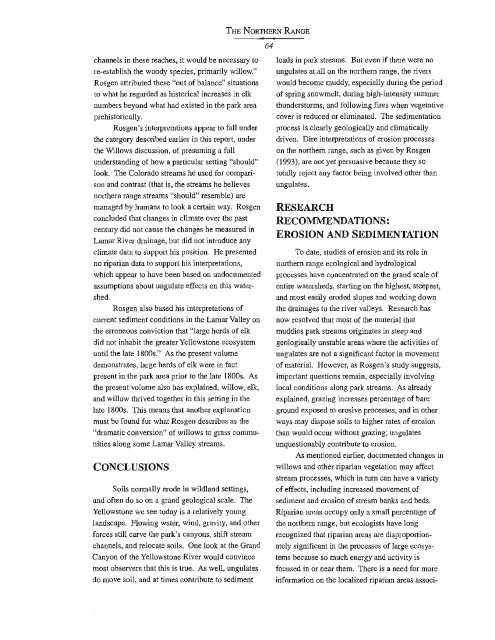Yellowstone's Northern Range - Greater Yellowstone Science ...
Yellowstone's Northern Range - Greater Yellowstone Science ...
Yellowstone's Northern Range - Greater Yellowstone Science ...
Create successful ePaper yourself
Turn your PDF publications into a flip-book with our unique Google optimized e-Paper software.
THE NORTHERN RANGE<br />
64<br />
channels in these reaches, it would be necessary to<br />
re-establish the woody species, primarily willow."<br />
Rosgen attributed these "out of balance" situations<br />
to what he regarded as historical increases in elk<br />
numbers beyond what had existed in the park area<br />
prehistorically.<br />
Rosgen's interpretations appear to fall under<br />
the category described earlier in this report, under<br />
the WIllows discussion, of presuming a full<br />
understanding of how a particular setting "should"<br />
look. The Colorado streams he used for comparison<br />
and contrast (that is, the streams he believes<br />
northern range streams "should" resemble) are<br />
managed by humans to look a certain way. Rosgen<br />
concluded that changes in climate over the past<br />
century did not cause the changes he measured in<br />
Lamar River drainage, but did not introduce any<br />
climate data to support his position. He presented<br />
no riparian data to support his interpretations,<br />
which appear to have been based on undocumented<br />
assumptions about ungulate effects on this watershed.<br />
Rosgen also based his interpretations of<br />
current sediment conditions in the Lamar Valley on<br />
the elToneous conviction that "large herds of elk<br />
did not inhabit the greater <strong>Yellowstone</strong> ecosystem<br />
until the late l800s." As the present volume<br />
demonstrates, large herds of elk were in fact<br />
present in the park area prior to the late l800s. As<br />
the present volume also has explained, willow, elk,<br />
and willow thrived together in this setting in the<br />
late 1800s. This means that another explanation<br />
must be found for what Rosgen describes as the<br />
"dramatic conversion" of willows to grass communities<br />
along some Lamar Valley streams.<br />
CONCLUSIONS<br />
Soils normally erode in wildland settings,<br />
and often do so on a grand geological scale. The<br />
<strong>Yellowstone</strong> we see today is a relatively young<br />
landscape. Flowing water, wind, gravity, and other<br />
forces still carve the park's canyons, shift stream<br />
channels, and relocate soils. One look at the Grand<br />
Canyon of the <strong>Yellowstone</strong> River would convince<br />
most observers that this is true. As well, ungulates<br />
do move soil, and at times contribute to sediment<br />
loads in park streams. But even if there were no<br />
ungulates at all on the northern range, the rivers<br />
would become muddy, especially during the period<br />
of spring snowmelt, during high-intensity summer<br />
thunderstorms, and following fires when vegetative<br />
cover is reduced or eliminated. The sedimentation<br />
process is clearly geologically and climatically<br />
driven. Dire interpretations of erosion processes<br />
on the northern range, such as given by Rosgen<br />
(1993), are not yet persuasive because they so<br />
totally reject any factor being involved other than<br />
ungulates.<br />
RESEARCH<br />
RECOMMENDATIONS:<br />
EROSION AND SEDIMENTATION<br />
To date, studies of erosion and its role in<br />
northern range ecological and hydrological<br />
processes have concentrated on the grand scale of<br />
entire watersheds, starting on the highest, steepest,<br />
and most easily eroded slopes and working down<br />
the drainages to the dver valleys. Research has<br />
now resolved that most of the material that<br />
muddies park streams originates in steep and<br />
geologically unstable areas where the activities of<br />
ungulates are not a significant factor in movement<br />
of material. However, as Rosgen's study suggests,<br />
important questions remain, especially involving<br />
local conditions along park streams. As already<br />
explained, grazing increases percentage of bare<br />
ground exposed to erosive processes, and in other<br />
ways may dispose soils to higher rates of erosion<br />
than would occur without grazing; ungulates<br />
unquestionably contribute to erosion.<br />
As mentioned earlier, documented changes in<br />
willows and other riparian vegetation may affect<br />
stream processes, which in turn can have a variety<br />
of effects, including increased movement of<br />
sediment and erosion of stream banks and beds.<br />
Riparian areas occupy only a small percentage of<br />
the northern range, but ecologists have long<br />
recognized that riparian areas are disproportionately<br />
significant in the processes of large ecosystems<br />
because so much energy and activity is<br />
focused in or near them. There is a need for more<br />
information on the localized riparian areas associ-















